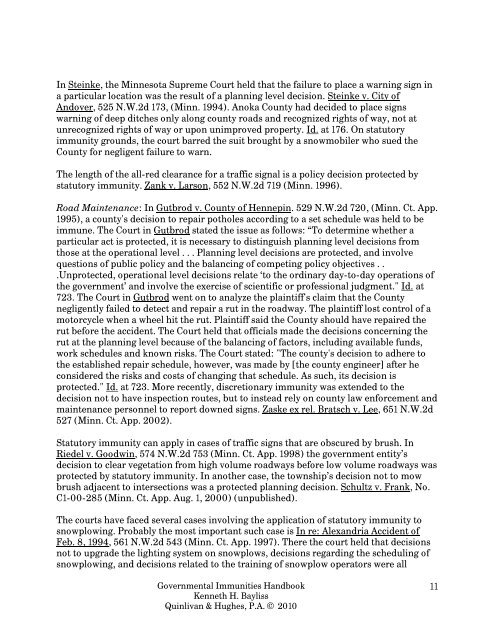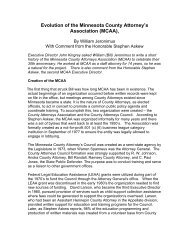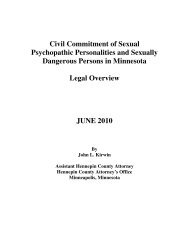Governmental Immunities: - Minnesota County Attorneys Association
Governmental Immunities: - Minnesota County Attorneys Association
Governmental Immunities: - Minnesota County Attorneys Association
You also want an ePaper? Increase the reach of your titles
YUMPU automatically turns print PDFs into web optimized ePapers that Google loves.
In Steinke, the <strong>Minnesota</strong> Supreme Court held that the failure to place a warning sign in<br />
a particular location was the result of a planning level decision. Steinke v. City of<br />
Andover, 525 N.W.2d 173, (Minn. 1994). Anoka <strong>County</strong> had decided to place signs<br />
warning of deep ditches only along county roads and recognized rights of way, not at<br />
unrecognized rights of way or upon unimproved property. Id. at 176. On statutory<br />
immunity grounds, the court barred the suit brought by a snowmobiler who sued the<br />
<strong>County</strong> for negligent failure to warn.<br />
The length of the all-red clearance for a traffic signal is a policy decision protected by<br />
statutory immunity. Zank v. Larson, 552 N.W.2d 719 (Minn. 1996).<br />
Road Maintenance: In Gutbrod v. <strong>County</strong> of Hennepin. 529 N.W.2d 720, (Minn. Ct. App.<br />
1995), a county's decision to repair potholes according to a set schedule was held to be<br />
immune. The Court in Gutbrod stated the issue as follows: “To determine whether a<br />
particular act is protected, it is necessary to distinguish planning level decisions from<br />
those at the operational level . . . Planning level decisions are protected, and involve<br />
questions of public policy and the balancing of competing policy objectives . .<br />
.Unprotected, operational level decisions relate ‘to the ordinary day-to-day operations of<br />
the government’ and involve the exercise of scientific or professional judgment." Id. at<br />
723. The Court in Gutbrod went on to analyze the plaintiff's claim that the <strong>County</strong><br />
negligently failed to detect and repair a rut in the roadway. The plaintiff lost control of a<br />
motorcycle when a wheel hit the rut. Plaintiff said the <strong>County</strong> should have repaired the<br />
rut before the accident. The Court held that officials made the decisions concerning the<br />
rut at the planning level because of the balancing of factors, including available funds,<br />
work schedules and known risks. The Court stated: "The county's decision to adhere to<br />
the established repair schedule, however, was made by [the county engineer] after he<br />
considered the risks and costs of changing that schedule. As such, its decision is<br />
protected." Id. at 723. More recently, discretionary immunity was extended to the<br />
decision not to have inspection routes, but to instead rely on county law enforcement and<br />
maintenance personnel to report downed signs. Zaske ex rel. Bratsch v. Lee, 651 N.W.2d<br />
527 (Minn. Ct. App. 2002).<br />
Statutory immunity can apply in cases of traffic signs that are obscured by brush. In<br />
Riedel v. Goodwin, 574 N.W.2d 753 (Minn. Ct. App. 1998) the government entity’s<br />
decision to clear vegetation from high volume roadways before low volume roadways was<br />
protected by statutory immunity. In another case, the township’s decision not to mow<br />
brush adjacent to intersections was a protected planning decision. Schultz v. Frank, No.<br />
C1-00-285 (Minn. Ct. App. Aug. 1, 2000) (unpublished).<br />
The courts have faced several cases involving the application of statutory immunity to<br />
snowplowing. Probably the most important such case is In re: Alexandria Accident of<br />
Feb. 8, 1994, 561 N.W.2d 543 (Minn. Ct. App. 1997). There the court held that decisions<br />
not to upgrade the lighting system on snowplows, decisions regarding the scheduling of<br />
snowplowing, and decisions related to the training of snowplow operators were all<br />
<strong>Governmental</strong> <strong>Immunities</strong> Handbook<br />
Kenneth H. Bayliss<br />
Quinlivan & Hughes, P.A. © 2010<br />
11






